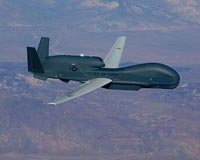| . |  |
. |
Patuxent River MD (SPX) Jun 15, 2010 The Lockheed Martin F-35 Joint Strike Fighter short takeoff/vertical landing (STOVL) variant flew faster than the speed of sound for the first time June 10, achieving a significant milestone. The aircraft accelerated to Mach 1.07 (727 miles per hour) on the first in a long series of planned supersonic flights. "For the first time in military aviation history, supersonic, radar-evading stealth comes with short takeoff/vertical landing capability," said Bob Price, Lockheed Martin's F-35 U.S. Marine Corps program manager. "The supersonic F-35B can deploy from small ships and austere bases near front-line combat zones, greatly enhancing combat air support with higher sortie-generation rates." The F-35B will enter service for the Marines, the United Kingdom's Royal Air Force and Royal Navy, and the Italian Air Force and Navy. The supersonic milestone was achieved on the 30th flight of the F-35B known as BF-2. U.S. Marine Corps pilot Lt. Col. Matt Kelly climbed to 30,000 feet and accelerated to Mach 1.07 in the off-shore supersonic test track near Naval Air Station Patuxent River. Future testing will gradually expand the flight envelope out to the aircraft's top speed of Mach 1.6, which the F-35 is designed to achieve with a full internal weapons load of more than 3,000 pounds. All F-35s are designed to launch internal missiles at maximum supersonic speed, as well as launch internal guided bombs supersonically. During the flight, Kelly accomplished 21 unique test points, including several Integrated Test Blocks to validate roll, pitch, yaw and propulsion performance. BF-2 is the third F-35 to achieve supersonic flight. Two F-35A conventional takeoff and landing variants also have broken the sound barrier. The F-35 program has about 900 suppliers in 45 states, and directly and indirectly employs more than 127,000 people. Thousands more are employed in the F-35 partner countries, which have invested more than $4 billion in the project. Those countries are the United Kingdom, Italy, the Netherlands, Turkey, Canada, Australia, Denmark and Norway. Three F-35 variants are under development - the F-35A CTOL variant to replace U.S. Air Force F-16s and A-10s, as well as aircraft employed by seven allied nations; the F-35B STOVL variant to replace U.S. Marine Corps AV-8B Harriers and F/A-18s, U.K. Royal Air Force and Royal Navy Harrier GR.7s, GR.9s and Sea Harriers, and Italian Harriers; and the F-35C carrier variant to replace U.S. Navy F/A-18s. The F-35 Lightning II is a 5th generation fighter, combining advanced stealth with fighter speed and agility, fully fused sensor information, network-enabled operations, advanced sustainment, and lower operational and support costs. Lockheed Martin is developing the F-35 with its principal industrial partners, Northrop Grumman and BAE Systems. Two separate, interchangeable turbofan engines are under development: the Pratt and Whitney F135 and the GE Rolls-Royce Fighter Engine Team F136.
Share This Article With Planet Earth
Related Links Lockheed Martin The latest in Military Technology for the 21st century at SpaceWar.com
 Northrop Grumman Submits Proposal For NATO Alliance Ground Surveillance
Northrop Grumman Submits Proposal For NATO Alliance Ground SurveillanceMelbourne FL (SPX) Jun 15, 2010 Northrop Grumman formally submitted its proposal this week for the NATO Alliance Ground Surveillance (AGS) system - NATO's top and long-running acquisition program. A contract award is anticipated in October 2010. "This program has been a model of the value of transatlantic cooperation to meet the security challenges of the 21st century, and we are proud to lead an industry team of more th ... read more |
|
| The content herein, unless otherwise known to be public domain, are Copyright 1995-2010 - SpaceDaily. AFP and UPI Wire Stories are copyright Agence France-Presse and United Press International. ESA Portal Reports are copyright European Space Agency. All NASA sourced material is public domain. Additional copyrights may apply in whole or part to other bona fide parties. Advertising does not imply endorsement,agreement or approval of any opinions, statements or information provided by SpaceDaily on any Web page published or hosted by SpaceDaily. Privacy Statement |